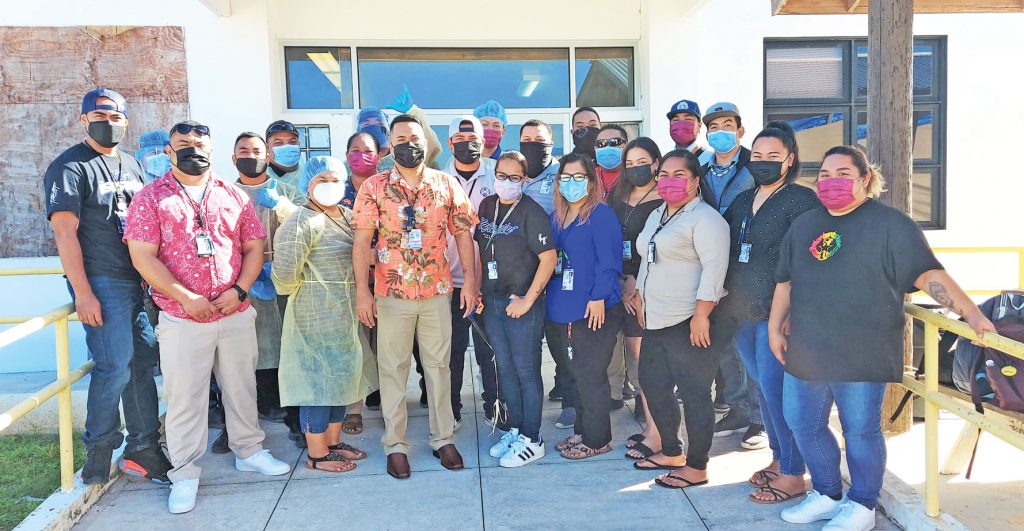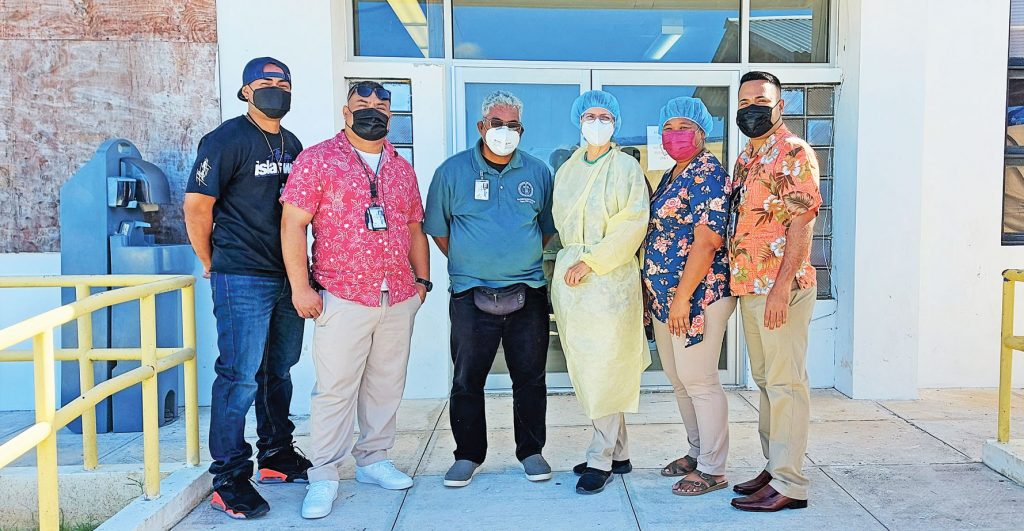PERSONS OF THE YEAR: COVID-19 contact tracing team
‘The guardians of the community’

The men and women of the Communicable Disease Investigation of the CNMI Contact Tracing Team. (BEA CABRERA)
Their work schedule says 8am to 5pm but that’s only on paper. The CNMI’s contact tracers work Sunday to Sunday and a usual day starts as early as 5am and often stretch all the way to 3am.
Right off the bat, one can see that it’s not a job just for anybody. It requires determination, vigilance, rapid action, and a clear understanding that you are part of a vast network designed to keep the CNMI as safe as possible during this COVID-19 pandemic.
And that has held true for the CNMI until late October this year. For several months, positive cases in the CNMI were detected right away at the border until October 2021, when the community was suddenly struck with a COVID-19 outbreak, one after the other, with the number of positive cases rising from single digits to triple digits. Many said it was bound to happen, but the COVID-19 contact tracing team that leads disease control are intimately aware that they must always be two steps ahead and working hard to prevent the spread of COVID-19, as if each member carries a torch to keep the light on so we can all sleep at night.
The increasing number of people being identified positive for COVID-19 is certainly concerning but it must also be pointed out that many of these new cases were identified via contact tracing, which speaks well of the rapidity and effectiveness of the Communicable Disease Inspection teams in finding the transmission routes. In this era of the COVID-19 pandemic, the contact tracing team stands as a guardian to break the chains of transmission of COVID-19 and keep the CNMI safe.
“Contact tracers may not have the medical background but they certainly have the courage to come face to face with those infected with the virus,” according to Commonwealth Healthcare Corp. CEO Esther Muña.

The Communicable Disease Investigation Team: From left, team leader Ben Lisua, team leader Vincent Kaipat, director for Environmental Health John Tagabuel, FEMA Situation Unit leader and licensed nurse Karen Buettner, team leader Juliet Laniyu, and CDI3 team leader Dwayne Davis. (BEA CABRERA)
Contact tracing includes the epidemiologist who provides guidance and support for the team and includes many other staff of CHCC that work together to minimize the further spread of the virus. “It is interwoven of all efforts from different sections of the CHCC and it includes other agencies within the Governor’s [COVID-19] Task Force. This includes the medical staff, nursing staff, laboratory staff, incident command operations staff, population health staff, Department of Fire and Emergency Medical Services, Alcohol, Beverage and Tobacco Control, Commonwealth Office of Transportation Authority, and communications, among many others,” Muña said.
The Communicable Disease Inspection Team under the Environmental Health and Disease Prevention, a team composed of assets from the Commonwealth Healthcare Corp. and other agencies of the Governor’s Task Force, holds office at the Koblerville COVID-19 Center where members of the community can go for their COVID-19 concerns.
The CDI Team is always racing against time as they work seven days a week, tallying the daily number of cases, identifying contacts and taking charge of how fast these contacts are isolated, whether at home or in a facility.
According to Communicable Disease Inspection 3 team leader Dwayne Davis, the team started with nine members. “It grew over the months. …We would like to say that our work schedule is 8am to 5pm but, in all honesty, we have not had that. We work Sunday to Sunday and a usual day starts at 5am and ends at 3am so these guys tend to work long hours. CDI3 is not just contact tracing because there are other areas they also focus on,” he said.
“Among those areas is airport surveillance. …We have a team in charge of transporting people, administrative, and coordination with the hospital. … Everybody is a contact tracer but just with specific roles in different areas,” he added.
The team is composed of different groups with a specific task on hand. Thirty two members currently devote their knowledge, skills, time and passion to keeping the community safe. Many of them started as volunteers when the CNMI experienced its first COVID-19 cluster in March 2019 and they stayed on.
Davis described the investigation and transportation units as the heart and soul of the operation that is headed by team leaders Vincent Kaipat and Ben Lisua and the liaison that connects CDI to the hospital is team leader Juliet Laniyu. He also pointed out that their efforts are not just focused on Saipan. “People think that we only have our eyes on Saipan, which is false. …We have built very strong teams on Tinian and Rota. Before the COVID-19 spread was declared a pandemic, we already went to Tinian and we have extended training on Rota to make sure these hubs are protected since both islands receive travelers,” Davis added.
Those methods that were put in place since the beginning has helped the CNMI manage COVID-19. “COVID-19 was expected to be here some time ago but because of the methods that we put out, the protocols we practice, we have managed to keep this bubble,” he said.
“We are the only U.S. territory that offers real time testing availability on many testing facilities on site on Saipan, Tinian, and Rota so the availability to get tested for detection is there,” said Davis.
He advised, though, that vaccination remains key. “If you want to adjust to some sense of normalcy, vaccination is the key and that is going to be a big factor into the transition. No sugar coating here but COVID is not going away,” he added.
Davis said that a representative from the World Health Organization was actually surprised with how the CDI executes its contact tracing process. “When an individual is identified, we do not just find them, identify their contacts, contain them and that’s it. We actually establish some kind of rapport with these people. …We deal with them, we would like to say 10 days but it even goes beyond that. …These are people and sometimes they just need someone to talk to or need additional information… so it doesn’t end when you identify an isolated case. We are here for the people even beyond the 14 days,” he added.
Team leader Vincent Kaipat echoes the rapport that they establish with the people they have contact with. “Sometimes I receive calls just because they want somebody to pray with them. Part of our work is also providing comfort and making individuals feel they are not alone,” he said.
Davis said the load of a team member can go beyond 10 hours a day, which sounds like heavy work but team members view their jobs not as merely work. “…Everybody here is a mother, a father, a sibling, or a son and daughter. …These people see what our known cases go through and what their family go through—the struggles of them being sick and separated from the family,” Davis said. “It’s not so much about working extended hours and there are compensations we qualify for but some of us do not even look at our check stubs. The motivation that moves us is we are the front-liners that either help, contain the spread of the virus, or save a life.”
Muña said the CNMI is in a better position now than if most of its population is not vaccinated.
“This community always considers others and not just themselves and that’s what makes the CNMI resilient. We have so much respect for our elders and our families that it is a big deal to follow public health measures of prevention so that we can protect them. That’s contributory to the single digit of acute and intensive care hospitalizations,” she said.
“For 2022 and beyond, we need to continue with that mindset of inafa’maolek—harmony, respect and protect—within our community to prevent severe illnesses and hospitalizations. …There is a lot of discussions of COVID-19 being an endemic and I believe CNMI is on the right path to transition to an endemic and recovery,” she added.
From a health perspective, Davis said the team’s overall goal is good health for its team members and the entire community. “…We would like to make sure that we pretty much covered loose ends, crossed our t’s and dotted our i’s to make sure we have promoted or provided educational material to motivate individuals who haven’t gotten the vaccine to get it. …Our objective for the coming year is to tell the community not to live in fear. …We want to be able to adjust and say that we are moving from a pandemic to an endemic concept. …We have our detection measures down, now we need to keep our prevention measures rolling, which is vaccination.”
“Getting the virus is not a matter of ‘if’ [but] a matter of ‘when,’ so the question everyone should be asking is, ‘Am I prepared? Have you taken steps to prepare yourself? …We want the community to know that we are here for them. …We are here prior, during the process or period of isolation and we are here for them after,” he added.























